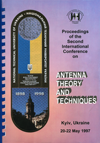Iteration technique of the design of frequency-selective devices and the software on this base
DOI:
https://doi.org/10.1109/ICATT.1997.1235218Abstract
Convertional methods of design of microwave frequency selective devices (FSD) can be divided into the methods, basing on preliminary circuit theory (CT) synthesis, and the methods, using direct numerical procedures of searching the geometry, that provides required frequency response. The short review of a third line of the approach to FSD design is given in this report. It may be called as an interaction one because of essential use of iteration processes for the fine-tuning final constructions of FSDs. Actually such an approach allows to take into account the influence of frequency dispersion of components, imitating lumped element of CT, as well as the dispersion of phase velocity in waveguide sections, multimode interaction of FSD components, and so on. On numerous occasions an iteration procedure turns out essentially time-saving one, comparing with direct numerical optimization even on the base of CT initial approximation.References
Kirilenko, A.A.; Senkevich, S.L.; Tkachenko, V.I.; Tysik, B.G. Waveguide diplexer and multiplexer design. IEEE Trans. Microwave Theory Tech., July 1994, Vol. MTT-42, p. 1393-1396.
Published
1997-05-24
Issue
Section
Microwave components and circuits, fiber-optic links

